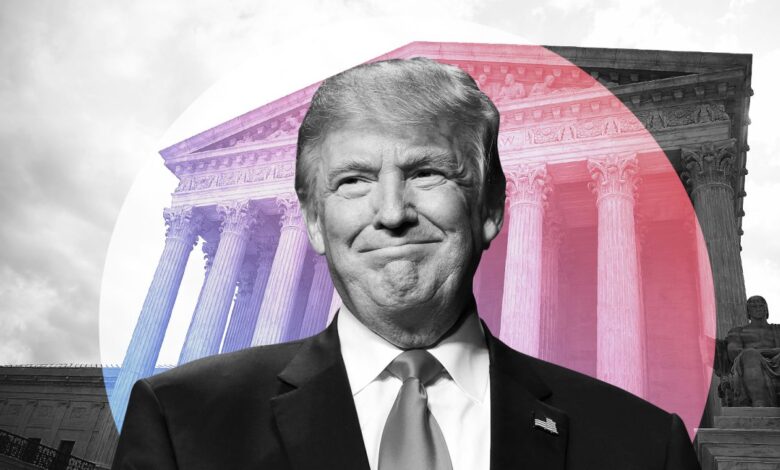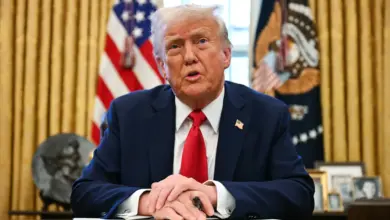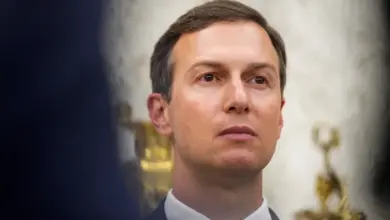
It’s not simply that the new administration has flouted a raft of federal statutes and prompted a flood of legal challenges. It’s that some of Donald Trump’s top advisers have cast doubt on whether rulings on those lawsuits would even constrain the president.
There are signs that some judges’ orders have been disregarded. On Monday, a federal judge in Rhode Island found that the administration has violated the “plain text” of his earlier order unfreezing billions of dollars in federal aid. The judge directed funding to be reinstated to environmental, health and other programs that had been cut off.
In a separate case Monday, in Washington, DC, federal employees told a judge that the administration had failed to reinstate USAID workers who were put on leave.
In fighting the cases, the Justice Department says the president should have the authority to decide how to run the government and that the judges are overreaching.
Chief Justice John Roberts may have presaged the turn of events six weeks ago as he warned at the end of December that “elected officials from across the political spectrum have raised the specter of open disregard for federal court rulings. These dangerous suggestions, however sporadic, must be soundly rejected.”
A commitment to the rule of law and judicial authority is engrained in the American way of life, tracing to the 1789 creation of the three-tiered federal bench.
Historically, the executive branch, even after vigorously fighting a case, has abided by a Supreme Court resolution. One notable example occurred in 1974, when President Richard Nixon initially refused to relinquish Oval Office tape recordings during the Watergate investigation but complied when the Supreme Court ruled against him.
Defiance so breaches the American norm that two episodes stand out, both in the 1800s, involving President Andrew Jackson’s refusal to enforce the Cherokee cases and President Abraham Lincoln’s Civil War suspension of the writ of habeas corpus.
“It just doesn’t happen,” Columbia University constitutional law professor Gillian Metzger said on Monday. “But it just doesn’t happen because there is a very deep-seated norm of law-following and commitment to the rule of law. … If we get to the point when we have the executive branch of the government refusing to follow orders of the court, we really are in ‘constitutional crises’-land and the president at that point is violating the ‘take care’ duty.”
Among the specific duties under Article II of the Constitution, the president “shall take Care that the Laws be faithfully executed.”
Even as their standing has ebbed and flowed, federal judges have benefitted from institutional respect over the centuries. Yet Trump’s early weeks in office have suddenly raised the prospect of the disobedience of court orders and an unfolding constitutional collapse.
Many of Trump’s executive orders arguably violate federal laws, for example, involving the severing of congressionally mandated funds and groundless firings of top officials. As the multitude of executive orders have faced early court scrutiny, Trump’s top advisers have questioned whether judges can block any of his agenda.
“If a judge tried to tell a general how to conduct a military operation, that would be illegal,” Vance said in a post on X. “If a judge tried to command the attorney general in how to use her discretion as a prosecutor that’s also illegal. Judges aren’t allowed to control the executive’s legitimate power.”
Vance has previously hinted at his disregard for high court rulings, declaring in a 2021 podcast that Trump could respond to adverse decisions “like Andrew Jackson did and say, ‘The chief justice has made his ruling. Now let him enforce it.’”
Scholars say that commonly invoked line, attributed to Jackson of Chief Justice John Marshall after the 1832 Worcester v. Georgia ruling, is likely apocryphal.
“The quote is not really fitting here,” added University of Chicago law professor Alison LaCroix, who is also a legal historian. “There was no order issued to the President Jackson. It was issued to Georgia,” which had asserted authority over members of the Cherokee Nation living there. (The Supreme Court ruled that federal jurisdiction was exclusive, so Georgia lacked the authority to control the Cherokees. But Jackson, who had pressed for “Indian removal,” refused to enforce the order and instead sent troops to forcibly remove the Cherokees, in what became known as “The Trail of Tears.”)
Meanwhile, Trump on Monday expanded on his criticisms of the judicial system, criticizing judges for wanting to “tell everybody how to run the country.”
“Judges should be ruling. They shouldn’t be dictating what you’re supposed to be doing,” Trump told radio host Mark Levin during an interview broadcast Monday night.
Calling balls and strikes
More pertinent to today’s controversy, LaCroix referred to the notion of judges as “umpires,” a concept she said existed in legal history well before Roberts famously used the metaphor in his 2005 Senate confirmation hearings.
“What we see the administration doing now is essentially saying there is no umpire,” LaCroix said, “and the entire playing field exists at the whim of the executive branch. And they don’t have to pay attention to what the other players are doing or the officials. And that is just antithetical to the Constitution in its text, but also in precedent.”
Vance is a graduate of Yale Law School, as is his wife, Usha, who served as a law clerk to Chief Justice Roberts during the 2017 to 2018 session. Both Vances would have been exposed to the entrenched academic understanding of judicial supremacy.
“At least throughout the 20th century, the settled understanding has been that it is the obligation of the president and any other official to accede to Supreme Court rulings,” said Harvard law professor Richard Fallon, who specializes in constitutional law and role of federal courts. “If the president wants to disobey, that would be a profoundly consequential step that would challenge our understanding of what the rule of law requires.”
It is often said, adapting Alexander Hamilton, that unlike the executive and legislative branches, the judiciary lacks the power of “the sword” or “the purse.” But the Third Branch has garnered sufficient public regard and moral authority to command adherence to its rulings since its late 18th century creation.
The touchstone for its power as the final arbiter of the law is the 1803 case of Marbury v. Madison, which established the court’s power to review acts of Congress and strike down those deemed unconstitutional.
Eisenhower sent troops to Little Rock
In the instances when people have refused to follow court orders, judges have held them in contempt or assessed fines. President Dwight Eisenhower, in a dramatic move to enforce the Supreme Court’s 1954 Brown v. Board of Education ruling, sent federal troops to Little Rock when Arkansas Gov. Orval Faubus defied a court-ordered desegregation plan and tried to prevent nine Black students from entering Central High School.
In these early weeks of Trump’s second term, federal district court judges – the first rung of the US judiciary – have begun impeding his efforts to transform the federal workforce, freeze government funding and overhaul the country’s immigration policy.
On Saturday, a federal judge temporarily restricted Musk’s government efficiency team from accessing the Treasury Department payment system that covers Social Security benefits and federal employees’ salaries, among other payments.
Musk responded by calling the judge “corrupt” and saying he “needs to be impeached.”
This story has been updated with additional information.
CNN’s Katelyn Polantz contributed to this report.




